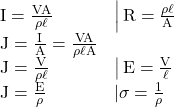According to classical free electron theory the electrons in a metal make random elastic collisions in all directions and the net current is zero.
- When a constant electric field is applied to the metal, the electrons are accelerated towards the positive of the field.
- During their movement, the random collisions are produced and it has attained a drift velocity Vd in the opposite direction of the applied electric field. The electrons move with an average velocity is called drift velocity.
- Drift velocity Vd is proportional to the applied electric field E.
i.e Vd ∞ E
Vd = μ E
- Where μ is called mobility of the electrons.
Mobility is defined as the drift velocity gained by the electron per unit electric field. μ = Vd / E, m2 V-1 s-1
- The steady state drift velocity of the electrons produces a current. (I)

![]()
- If ‘ n ‘ is the concentration of free electrons then the current density ‘ J’ can be written as

From Ohm’s law ![]()

J = σ E
Where σ is electrical conductivity

Conclusions
Thus the electrical conductivity is directly proportional to the mobility of electrons.
- Mobility of the electron depends on temperature

- When the temperature of the metal increases, the mobility of the electron decreases and hence the electrical conductivity decreases.
- The addition of impurities in the metal decreases the electrical conductivity.
| Read More Topics |
| Industrial applications laser welding |
| Types of semiconductor laser |
| Principle and propagation of light in optical fibres |





